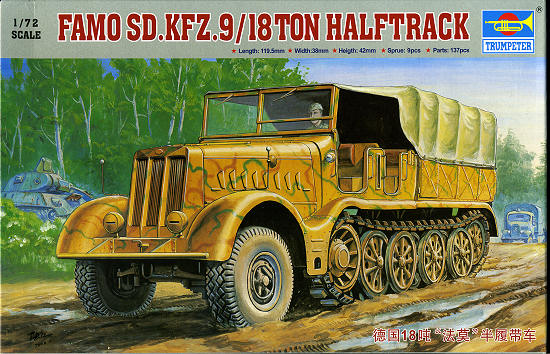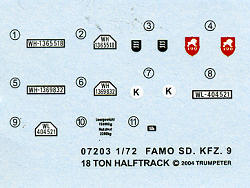
Trumpeter 1/72 Sd.Kfz 9 18 Ton Halftrack
| KIT: | Trumpeter 1/72 Sd.Kfz 9 18 Ton Halftrack |
| KIT #: | 07203 |
| PRICE: | $24.98 MSRP |
| DECALS: | Three options |
| REVIEWER: | Scott Van Aken |
| NOTES: |

| HISTORY |
The heaviest of the German halftracks was the schwerer Zugkraftwagen 18t (SdKfz 9) FAMO F3. So named after its only producer (Fahrzeug und Motorenbau GmbH 'FAMO' Breslau, Oberschlesien), the primary task of these 15t behemoths was for towing tank trailers weighing up to 35 tons. Other versions included a crane vehicle and a Flak mount.
Powered by a 12 cylinder Maybach HL 108 TUKRM engine, they had a loading capacity of 2.8 tons and a towing capacity of 18 tons. Crew was 8. 2000 of this version were produced.
Late in the war this chassis was used for an 88mm Flak 36 anti-aircraft mount. The cab and engine compartment were armored in the same fashion as the lighter 8t SdKfz 7/2. Only a few of these later versions were completed.
| THE KIT |
 I'm not sure how long Trumpeter has been doing 1/72 military vehicles, but this one is dated 2005, making it almost ancient in company history. With 137 parts on 9 sprues, it is one of the more parts intensive kits around in this scale.
I'm not sure how long Trumpeter has been doing 1/72 military vehicles, but this one is dated 2005, making it almost ancient in company history. With 137 parts on 9 sprues, it is one of the more parts intensive kits around in this scale.
One of the reasons for the high parts count is that this is a pretty detailed kit. Thanks to the open chassis, there is a lot to see and so trumpeter has decided to provide as many parts as it can to enhance that feeling of detail. A full engine is part of the deal, something one rarely sees in 1/72 scale vehicles. A large transmission and drive section along with a winch helps to make up the chassis.
Multiple road wheels for the tracked portion are provided and one has to build up the track assembly, which counts for a goodly number of the parts. Fortunately, Trumpeter has provided a construction guide on which to build the tracks. One can do either a 47 or 49 track link. How one determines which is appropriate is beyond me, but that is what the instructions state.
The upper section of the Famo is equally detailed with a complete driver's compartment and a nicely detailed bed. I would have thought that perhaps there would be a bunch of seats in the rear, but that is not the case. The vehicle can be built with the framework of the rear section either up or down. An already molded 'down' assembly is provided and for those wishing to have the framework in place, a guide for bending the wire is given. No canvas top option is given so to do what is shown on the box art will take a bit of ingenuity on the part of the builder. I should also mention that a template is given for cutting out clear acetate for the windows. Another option provided is a draw bar in case you wish to use it in a diorama.
and for those wishing to have the framework in place, a guide for bending the wire is given. No canvas top option is given so to do what is shown on the box art will take a bit of ingenuity on the part of the builder. I should also mention that a template is given for cutting out clear acetate for the windows. Another option provided is a draw bar in case you wish to use it in a diorama.
Instructions are well done with all the various color information provided using Gunze paint numbers. No cross reference guide is provided to tell us just what those colors are. Markings are for three vehicles. Two of them are like the box art vehicle in Panzer yellow with green and brown stripes. One for the 237th Panzer Brigade in Russia during 1943 and the other for the 190th StuG Brigade in Russia during 1943. A third option is for the Hermann Goring Workshop Battalion in Germany during 1942. This vehicle is in overall Panzer Grey. The small decal sheet is well printed and should work well, though one will probably need setting solution.
| CONCLUSIONS |
This vehicle was the largest of Germany's few prime movers and used on all fronts during the war. It should build into a most impressive model in this scale and is something that halftrack fans need to have in their collection.
| REFERENCES |
May 2008
Thanks to me and store credit for this one.
If you would like your product reviewed fairly and fairly quickly, please contact the editor or see other details in the Note to Contributors.